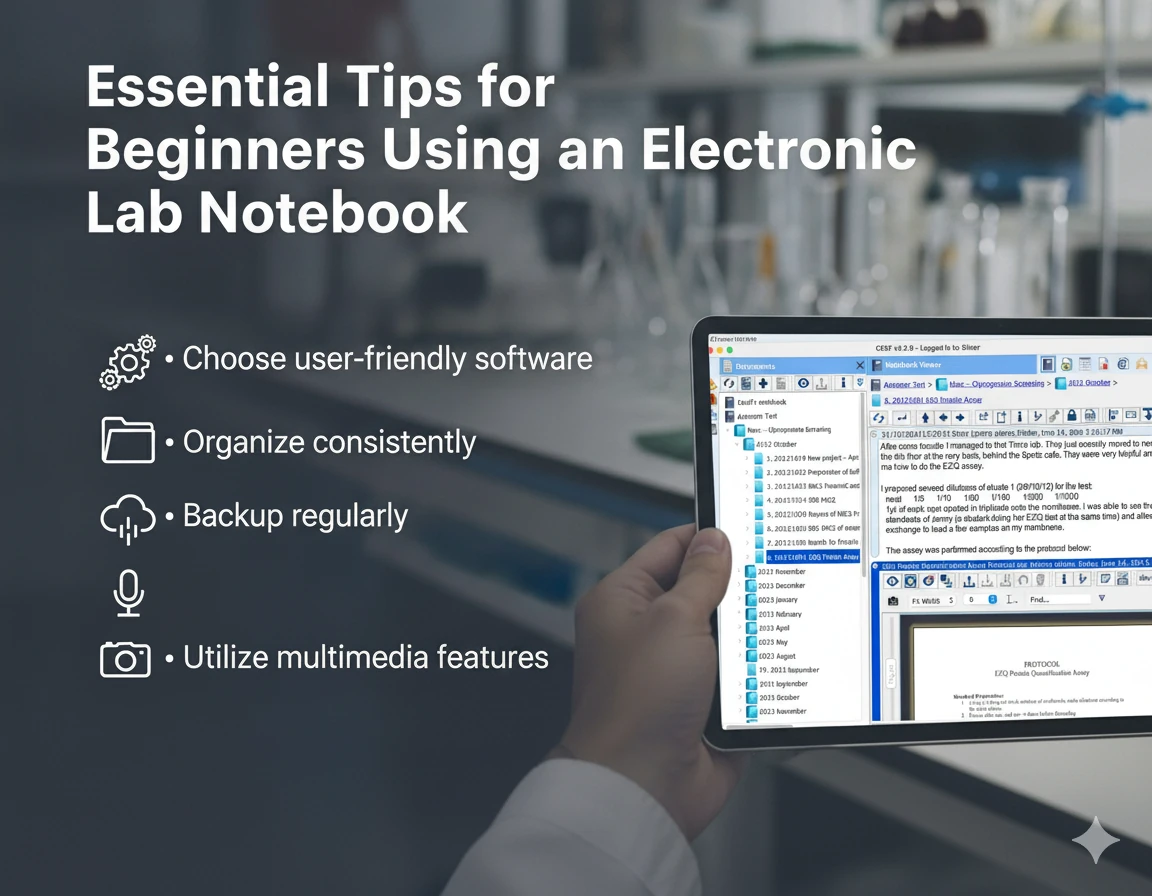An electronic lab notebook (ELN) can significantly streamline your research, but getting started requires good habits and an understanding of best practices. Building upon basic ELN concepts, here are some expanded tips for beginners:
Establish a Consistent Structure and Use Templates
- Standardize Entries: Create and utilize templates for common experiments or procedures. This ensures that all critical information is captured consistently, speeds up record-keeping, and makes it easier for others (and your future self) to understand your work. Sections might include: Date, Title of Experiment, Objective, Rationale, Materials, Methods, Results, Conclusions, File Location, Sample Location, and Next Steps.
- Organize by Project/Study: Decide on a clear organizational structure early on. This could be by project, study type (e.g., strain generation, protein extraction), or team. Use clear headings, labels, and tags (keywords) to differentiate sections and improve searchability.
- Table of Contents: Most ELNs automatically generate a table of contents. If yours doesn’t, create one manually at the beginning of your notebook to quickly find previous experiments.
- Metadata: Use consistent terms relative to your organization. Metadata should provide valuable reminders about resource content and experiment recordings. Many ELNs provide a rich set of structed data that is easily searchable to help you locate important documentation.
Record Comprehensive and Accurate Details
- Write as You Go: Document your experiments and observations daily. The longer you wait, the more likely you are to forget important details.
- Capture Everything: Record all aspects of your experiment, including procedures, reagents (name, source, lot number, expiration, storage), equipment used, observations (planned and unplanned), raw data, and data analysis.
- Document Mistakes and Failures: It’s crucial to record all mistakes, unexpected results, and deviations from protocols. Do not erase or obliterate errors; instead, cross them out with a single line, write the correction, and initial/date it. This maintains data integrity and can be invaluable for troubleshooting or even leading to new discoveries.
- Include Conclusions and Next Steps: Even brief bullet points summarizing your conclusions and outlining next steps for an experiment are helpful for reflecting on your results and planning future work.
- Reference Protocols: While your ELN should not be an encyclopedia of all lab protocols, you can reference existing protocols briefly or create new general protocols within your ELN. Maintain a separate protocol binder or section for detailed protocols.
- Be Specific: Note details like brand, vendor, and specifications for reagents and materials. This helps others replicate your work.
Prioritize Data Integrity and Security
- No Alterations: ELNs provide an audit trail that records every change, timestamp, and user. This feature is critical for data integrity and compliance. Avoid using features that allow for easy deletion or untraceable modifications of data.
- Secure Access: Utilize security features like two-factor authentication and unique credentials. Understand that your notebook might be the property of your institution, and PIs often prefer notebooks to stay in the lab for security and accessibility.
- Back Up Your Data: Regularly back up your ELN content. For cloud-based ELNs, ensure the provider has robust security infrastructure and backup protocols.
Leverage Collaboration and Sharing Features
- Facilitate Teamwork: ELNs are excellent for collaboration. Learn how to share notes, projects, and protocols with specific team members. Many ELNs allow for comments, messaging, and assigning tasks, which can greatly improve team communication.
- User Permissions: Understand user groups and permissions within your ELN to control access to sensitive data while enabling effective collaboration.
Maintain Good Workflow and Habits
- Onboarding and Training: If your lab has established onboarding procedures or training for the ELN, actively participate.
- Regular Review: Ask your research mentor or PI to review your notebook periodically to ensure your notes are detailed enough and that you are following best practices.
- Offboarding Procedures: Understand the offboarding procedures for your ELN, including transferring or assigning ownership of your work to the appropriate contact when necessary.
- Searchability: Make use of keywords and tags, and standardize naming conventions for projects, experiments, and files to ensure easy search and retrieval of information later on.
By adopting these tips, you can transform your ELN into a powerful tool for efficient data management, reproducibility, and successful research.
Further Resources
- 8 Tips on Keeping an Electronic Lab Notebook – ZAGENO
- Electronic Lab Notebooks – Harvard Biomedical Data Management
- Ten simple rules for implementing electronic lab notebooks (ELNs) – PubMed Central
- Keeping an Electronic Lab Notebook – NIH Office of Intramural Research
- Electronic Lab Notebook Best Practices: How to Use Your ELN Effectively – Sapio Sciences

